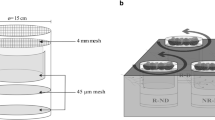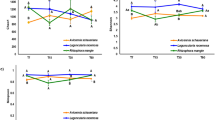Abstract
In all terrestrial ecosystems, testate amoebae (TA) encounter fungi. There are strong indications that both groups engage in multiple interactions, including mycophagy and decomposition of TA shells, processes which might be fundamental in nutrient cycling in certain ecosystems. Here, we present the results of an experiment focusing on interactions between TA and saprotrophic microfungi colonizing Scots pine (Pinus sylvestris L.) litter needles. The needles were collected from a temperate pine forest and cultivated in damp chambers. Over a few weeks, melanized mycelium of Anavirga laxa Sutton started to grow out of some needles; simultaneously, the common forest-soil TA Phryganella acropodia (Hertwig and Lesser) Hopkinson reproduced and spread around the mycelium. We investigated whether a potential relationship between TA and saprotrophic microfungi exists by comparing the composition of TA communities on and around the needles and testing the spatial relationship between the A. laxa mycelium and P. acropodia shells in the experimental microcosm. Additionally, we asked whether P. acropodia utilized the A. laxa mycelium as a nutrient source and screened whether P. acropodia shells were colonized by the microfungi inhabiting the experimental microcosm. Our results indicate that saprotrophic microfungi may affect the composition of TA communities and their mycelium may affect distribution of TA individuals in pine litter. Our observations suggest that P. acropodia did not graze directly on A. laxa mycelium, but rather fed on its exudates or bacteria associated with the exudates. The fungus Pochonia bulbillosa (Gams & Malla) Zare & Gams was often found parasitising encysted shells or decomposing already dead individuals of P. acropodia. TA and pine litter microfungi engage in various direct and indirect interactions which are still poorly understood and deserve further investigation. Their elucidation will improve our knowledge on fundamental processes influencing coexistence of soil microflora and microfauna.





Similar content being viewed by others
References
Aoki Y, Hoshino M, Matsubara T (2007) Silica and testate amoebae in a soil under pine-oak forest. Geoderma 142:29–35
Balík V (1992) Testate amoebae fauna (Protozoa, Rhizopoda, Testacea) from the marsh habitats in the Krkonoše Mountains National Park (Czechoslovakia). Opera Corcontica 29:139–154
Balík V (1994) Testaceenfauna (Protozoa, Rhizopoda, Testacea) aus dem Naturschutzgebiet Žofínský prales (Novohradské hory Gebirge) in Südböhmen (Tschechische Republik). Act Mus Boh Meridion Č Budějovice 34:55–67
Bamforth SS (1971) Numbers and proportions of Testacea and Ciliates in litters and soils. J Protozool 18:24–28
Bartoš E (1954) Koreňonožce radu Testacea. Vydavaťelstvo Slovenskej Akadémie Vied, Bratislava, pp 1–185
Bonkowski M, Jentschke G, Scheu S (2001) Contrasting effects of microbial partners in the rhizosphere: interactions between Norway Spruce seedlings (Picea abies Karst.), mycorrhiza (Paxillus involutus (Batsch) Fr.) and naked amoebae (protozoa). Appl Soil Ecol 18:193–204
Chakraborty S, Theodorou C, Bowen GD (1985) The reduction of root colonization by mycorrhizal fungi by mycophagous amebas. Can J Microbiol 31:295–297
Coleman DC (2008) From peds to paradoxes: linkages between soil biota and their influences on ecological processes. Soil Biol Biochem 40:271–289
Coûteaux MM (1975) Écologie des thécamoebiens de quelques humus bruts forestiers. Rev Écol Biol Sol 12:421–447
Coûteaux MM (1976) Dynamisme de l’equilibre des thécamoebiens dans quelques sols climaciques. Mem Mus Natl Hist Nat A Zool 96:1–183
Coûteaux MM, Dévaux J (1983) Effet d’un enrichissement en champignons sur la dynamique d’un peuplement thécamoebien d’un humus. Rev Écol Biol Sol 20:519–545
Coûteaux MM (1985) Relationships between testate amebas and fungi in humus microcosms. Soil Biol Biochem 17:339–345
Couteaux MM, Darbyshire JF (1998) Functional diversity amongst soil protozoa. Appl Soil Ecol 10:229–237
Couteaux MM (1992) Decomposition of cells and empty shells of testate amebas (Rhizopoda, Testacea) in an organic-acid soil sterilized by propylene-oxide fumigation, autoclaving, and gamma-ray irradiation. Biol Fert Soil 12:290–294
Deflandre G (1929) Le genre Centropyxis Stein. Arch Protistenkd 67:322–375
Deflandre G (1936) Etude monographique sur le genre Nebela Leidy. Ann Protistologie 5:201–286
De Santo AV, Rutigliano FA, Berg B, Fioretto A, Puppi G, Alfani A (2002) Fungal mycelium and decomposition of needle litter in three contrasting coniferous forests. Acta Oecol 23:247–259
Ellis MB, Ellis JP (1997) Microfungi on land plants. Richmond Publishing, Slough
Fassatiová O, Lysek H (1982) Ovicidal fungi in soil ecological system. Acta Univ Carol Biol 9:297–334
Gilbert D, Amblard C, Bourdier G, Francez A-J (1998) The microbial loop at the surface of a peatland: structure, function, and impact of nutrient input. Microb Ecol 35:83–93
Gilbert D, Amblard C, Bourdier G, Francez A-J (1998) Short-term effect of nitrogen enrichment on the microbial communities of a peatland. Hydrobiologia 373(374):111–119
Gilbert D, Mitchell EAD, Amblard C, Bourdier G, Francez A-J (2003) Population dynamics and food preferences of the testate amoeba Nebela tincta major-bohemica-collaris complex (Protozoa) in a Sphagnum peatland. Acta Protozool 42:99–104
Goreaud F, Pelissier R (2003) Avoiding misinterpretation of biotic interactions with the intertype K12-function: population independence vs. random labeling hypotheses. J Veget Sci 14:681–692
Hammer Ř, Harper DAT, Ryan PD (2001) PAST: palaeontological statistics software package for education and data analysis. Palaeontol Electronica 4:9
Han BP, Wang T, Lin QQ, Dumont HJ (2008) Carnivory and active hunting by the planktonic testate amoeba Difflugia tuberspinifera. Hydrobiologia 596:197–201
Hayes AJ (1965) Some microfungi from Scots pine litter. Trans Br Mycol Soc 48:179–185
Hogberg MN, Hogberg P (2002) Extramatrical ectomycorrhizal mycelium contributes one-third of microbial biomass and produces, together with associated roots, half the dissolved organic carbon in a forest soil. New Phytol 154:791–795
Hasna I, Rämert L (2007) Food attraction and population growth of fungivorous nematodes with different fungi. Ann Appl Biol 151:175–182
Illian J, Penttinen A, Stoyan H, Stoyan D (2008) Statistical analysis and modelling of spatial point patterns. Wiley-Interscience, Chichester
Ingham ER, Massicotte HB (1994) Protozoan communities around conifer roots colonized by ectomycorrhizal fungi. Mycorrhiza 5:53–61
Koehn FE, Kirsch DR, Feng X, Janso J, Young Y (2008) A cell wall-active lipopeptide from the fungus Pochonia bulbillosa. J Nat Prod 71:2045–2048
Koukol O (2007) Effect of Pinus strobus L. invasion on the mycoflora of pine litter needles in the Bohemian Switzerland National Park (Czech Republic). In: Härtel H et al (eds) Sandstone landscapes. Academia, Praha, p 493
Krashevska V, Bonkowski M, Maraun M, Ruess L, Kandeler E, Scheu S (2008) Microorganisms as driving factors for the community structure of testate amoebae along an altitudinal transect in tropical mountain rain forests. Soil Biol Biochem 40:2427–2433
Lindahl BD, Ihrmark K, Boberg J, Trumbore SE, Högberg P, Stenlid J, Finlay R (2007) Spatial separation of litter decomposition and mycorrhizal nitrogen uptake in a boreal forest. New Phytol 173:611–620
Lousier JD (1974) Effects of experimental soil-moisture fluctuations on turnover rates of Testacea. Soil Biol Biochem 6:19–26
Lousier JD (1974) Response of soil Testacea to soil-moisture fluctuations. Soil Biol Biochem 6:235–239
Lousier JD (1982) Colonization of decomposing deciduous leaf litter by Testacea (Protozoa, Rhizopoda)—species succession, abundance, and biomass. Oecologia 52:381–388
Lousier JD, Parkinson D (1984) Annual population dynamics and production ecology of Testacea (Protozoa, Rhizopoda) in an aspen woodland soil. Soil Biol Biochem 16:103–114
Miller RM, Reinhardt DR, Jastrow JD (1995) External hyphal production of vesicular-arbuscular mycorrhizal fungi in pasture and tallgrass prairie communities. Oecologia 103:17–23
Mitchell CP, Millar CS, Minter DW (1978) Studies on decomposition of Scots pine needles. Trans Br Mycol Soc 71:343–348
Moosavi M-R, Zare R, Zamanizadeh H-R, Fatemy S (2010) Pathogenicity of Pochonia species on eggs of Meloidogyne javanica. J Invertebr Pathol 104:125–133
Napolitano JJ, Flanagan VD (1981) Occurrence of amebas in and around the mushroom Laccaria trullisata. J Protozool 28:494–497
Ogden CG, Hedley RH (1980) An atlas of freshwater testate amoebae. Oxford University Press, Oxford, p 222
Ogden CG, Pitta P (1990) Biology and ultrastructure of the mycophagus, soil testate ameba, Phryganella acropodia (Rhizopoda, Protozoa). Biol Fert Soils 9:101–109
Patterson RT, Dalby A, Kumar A, Henderson LA, Boudreau EA (2002) Arcellaceans (thecamoebians) as indicators of land-use change: settlement history of the Swan Lake area, Ontario as a case study. J Paleolimn 28:297–316
Ponge JF (1991) Succession of fungi and fauna during decomposition of needles in a small area of Scots pine litter. Plant Soil 138:99–113
Ponge JF (1991) Food resources and diets of soil animals in a small area of Scots pine litter. Geoderma 49:33–62
Schönborn W (1986) Population dynamics and production biology of testate amebas (Rhizopoda, Testacea) in raw humus of 2 coniferous forest soils. Arch Protistenkd 132:325–342
Schönborn W (1992) Comparative studies on the production biology of protozoan communities in freshwater and soil ecosystems. Arch Protistenkd 141:187–214
Sutton CA, Wilkinson DM (2007) The effects of Rhododendron on testate amoebae communities in woodland soils in north west England. Acta Protozool 46:333–338
Sutton BC (1975) Hyphomycetes on cupules of Castanea sativa. Trans Br Mycol Soc 64:405–426
Timonen S, Christensen S, Ekelund F (2004) Distribution of protozoa in Scots pine mycorrhizospheres. Soil Biol Biochem 36:1087–1093
Todorov M (2001) Testate amoebae (Protozoa: Rhizopoda) in soil and litter of beech forests (Fagus sylvatica L.) from Bulgaria. Act Zool Bulg 53:19–36
Tokumasu S, Aoki T, Oberwinkler F (1994) Fungal succession on pine needles in Germany. Mycoscience 35:29–37
van Maanen A, Gourbière F (1997) Host and geographical distribution of Verticicladium trifidum, Thysanophora penicillioides, and similar fungi on decaying coniferous needles. Can J Bot 75:699–710
Vohník M, Burdíková Z, Albrechtová J, Vosátka M (2009) Testate amoebae (Arcellinida and Euglyphida) vs. ericoid mycorrhizal and DSE fungi: a possible novel interaction in the mycorrhizosphere of ericaceous plants? Microb Ecol 57:203–214
White JF, Bacon CW, Hywel-Jones NL, Spatafora JW (2003) Clavicipitalean fungi: evolutionary biology, chemistry, biocontrol, and cultural impacts. CRC Press, Boca Raton, p 575
Wilkinson DM (2008) Testate amoebae and nutrient cycling: peering into the black box of soil ecology. Trend Ecol Evol 23:596–599
Wilkinson DM, Mitchell EAD (2010) Testate amoebae and nutrient cycling with particular reference to soils. Geomicrobiol J 27:520–533
Yeates GW, Foissner W (1995) Testate amebas as predators of nematodes. Biol Fert Soils 20:1–7
Zare R, Gams W, Evans HC (2001) A revision of Verticillium section Prostrata. V. The genus Pochonia, with notes on Rotiferophthora. Nova Hedwig 73:51–86
Zucconi L, Pasqualetti M (2007) Microfungal assemblage on Quercus ilex leaf litter in Tuscany, central Italy. Plant Biosyst 141:305–313
Acknowledgement
This study was supported by the Academy of Sciences of the Czech Republic (research projects AV0Z60050516 and AV0Z50110509), Ministry of Education, Youth and Sports (research program LC06063) and Grant Agency of the Czech Republic (206/09/P295 and 204/09/H084). The authors thank David M. Wilkinson and Humphrey G. Smith for valuable comments on the results of the experiment, four anonymous reviewers for their valuable effort, and Jesse J. Sadowsky for a stylistic revision. MV thanks the foundation “Nadání Josefa, Marie a Zdenky Hlávkových” for funding his stay at Liverpool John Moores University, Liverpool, UK.
Author information
Authors and Affiliations
Corresponding author
Rights and permissions
About this article
Cite this article
Vohník, M., Burdíková, Z., Vyhnal, A. et al. Interactions Between Testate Amoebae and Saprotrophic Microfungi in a Scots Pine Litter Microcosm. Microb Ecol 61, 660–668 (2011). https://doi.org/10.1007/s00248-010-9777-4
Received:
Accepted:
Published:
Issue Date:
DOI: https://doi.org/10.1007/s00248-010-9777-4




